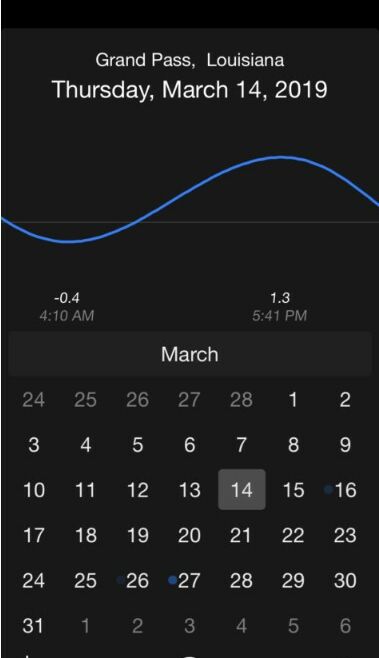
Tide Chart
The Nitty Gritty dirt band talked about the “lazy yellow moon coming up tonight”. Fishermen talk about that same moon probably more than they even realize. Its hard to believe that something so far away can affect our success as anglers so much. The moon plays a role in many areas of fishing, major and minor feeding times, spawning times, visibility at night, and most commonly in our tides People generally have a lot of questions about tides and they directly benefit our ability to catch fish. In a lot of my seminars I tell people that the three main things to look for while trout fishing is relatively clean water, moving water, and bait. The general rule of thumb is that the first hour or so of tide movement and the last hour or so of tide movement produce the most success. Bait is the constant in our pursuit of speckled trout. If there is nothing to eat in an area these fish will move on to a different area. If there is bait around but it is well hidden with no forces causing it to move the bite is going to be slow. What moves bait? Water flow moves bait. Here in South Mississippi and South Louisiana our tides are what moves that bait in and out of marsh grass and ditches. These tides will carry that bait across our oyster reefs. That same tide will also carry clean water into these productive areas. It can also turn a great spot into a muddy mess. This is why it is important to understand what you are looking at when checking the tide.
It is also important to know the factors that can cause errors in that tide prediction. A tide chart is just that, a prediction. There are variables that have to be factored into. Having an intimate knowledge of how water moves through an are that you fish is very important, wind is one of the largest factors that will affect the accuracy of a tide prediction. This past week I got to the marsh about two hours after the tide was predicted to stop falling. As I was approaching my first stop I noticed water still falling out of the pond. It was doing so because we had a NW wind that day. This brings me to a great point, one thing that people simply don’t think of is to just look at the water. The easiest way to tell if the water is rising or falling is to simply look.
Here in the MS Sound and SE LA waters when we get a big E of SE wind it can push a lot of clean gulf water. On these days expect to see the tide rise longer than forecast. In the chart above it says high tide is at 5:41PM, if we had a 10-20 mph Easterly wind you could expect the tide to keep rising anywhere from an hour to two hours more than that. On the other hand a Westerly wind is going increase the time that the water will fall. A strong Westerly wind in these waters will also cause dirty water in a lot of areas. When the water level drops below normal range the bayous and ditches get very low and that will pull dirty water out of them. Take all of these factors into consideration when you are planning a trip.
Tidelines are a great place to look for trout. Rising or falling tide doesn’t matter as much. If there is a good point it will likely create a tide line. Trout love to capitalize on these as ambush points. They will either sit in the current or the eddies created by the tide line and wait on bait to come to them. Google earth is a great place to do some scouting while you are at home. It is very easy to find tide lines using aerial imagery. You can also use their historical tool to view past images and find structure that used to be above the water but is now underwater. Good luck out there! Maybe I will see you on the water.
